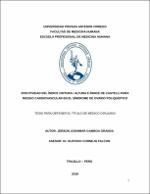Efectividad del índice cintura/altura e índice de Castelli para riesgo cardiovascular en el síndrome de ovario poliquístico

View/
Download
(application/pdf: 515.0Kb)
(application/pdf: 515.0Kb)
Date
2019Author(s)
Gamboa Granda, Jerson Joshimar
Metadata
Show full item recordAbstract
Objetivo: Determinar la efectividad del Índice cintura / altura y del Índice de
Castelli para valorar el Riesgo cardiovascular en el Ssíndrome de Ovario
Poliquístico en el Hospital de Apoyo Tomas Lafora - Guadalupe durante el
periodo 2018.
Material y métodos: Se llevó a cabo un estudio retrospectivo seccional de
pruebas diagnósticas en el que se incluyeron a 73 pacientes con síndrome
de ovario poliquístico, según criterios de selección los cuales se dividieron en
2 grupos: riesgo cardiovascular elevado o no elevado; calculándose el área
bajo la curva para el Índice cintura / altura y el Índice de Castelli.
Resultados: En la muestra estudiada la distribución del riesgo
cardiovascular según el score de Framingham fue el siguiente: riesgo alto 0
pacientes (0%); riesgo moderado 13 pacientes (18%) y riesgo bajo 60
pacientes (82%); la sensibilidad, especificidad, valor predictivo positivo y
valor predictivo negativo del índice cintura / altura en la predicción del Riesgo
cardiovascular incrementado en Síndrome de Ovario Poliquístico fue de
92%; 87%; 60% y 98% respectivamente; la sensibilidad, especificidad, valor
predictivo positivo y valor predictivo negativo del índice de Castelli en la
predicción del Riesgo cardiovascular incrementado en Síndrome de Ovario
Poliquístico fue de 85%; 83%; 52% y 96% respectivamente; la exactitud
pronostica del índice cintura/altura y del índice de Castelli fueron de 75% y
73% respectivamente.
Conclusión: El índice cintura / altura y del Índice de Castelli son efectivos
para valorar el Riesgo cardiovascular en el Ssíndrome de Ovario Poliquístico
en el Hospital de Apoyo Tomas Lafora - Guadalupe durante el periodo 2018. Objective: To determine the effectiveness of the Waist Height Index and the
Castelli Index to assess the cardiovascular risk in Polycystic Ovarian
Syndrome at the Tomas Lafora - Guadalupe Support Hospital during the 2018
period.
Material and methods: A retrospective study of diagnostic tests was carried
out in which 73 patients with polycystic ovary syndrome were included,
according to selection criteria which were divided into 2 groups: elevated or
not elevated cardiovascular risk; calculating the area under the curve for the
Waist Height Index and the Castelli Index.
Results: In the sample studied, the distribution of cardiovascular risk
according to the Framingham score was as follows: high risk 0 patients (0%);
moderate risk 13 patients (18%) and risk under 60 patients (82%); the
sensitivity, specificity, positive predictive value and negative predictive value
of the waist / height ratio in the prediction of increased cardiovascular risk in
Polycystic Ovarian Syndrome was 92%; 87%; 60% and 98% respectively; the
sensitivity, specificity, positive predictive value and negative predictive value
of the Castelli index in the prediction of increased cardiovascular risk in
Polycystic Ovarian Syndrome was 85%; 83%; 52% and 96% respectively; the
prediction accuracy of the waist / height index and the Castelli index were
75% and 73% respectively.
Conclusion: The Waist Height Index and the Castelli Index are effective to
assess the cardiovascular risk in Polycystic Ovarian Syndrome at the Tomas
Lafora - Guadalupe Support Hospital during the 2018 period.
Collections
- Medicina Humana [2969]

